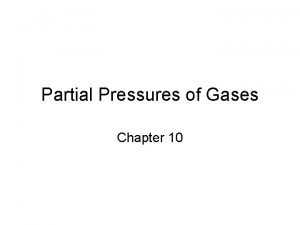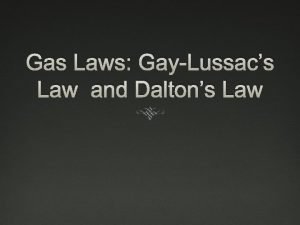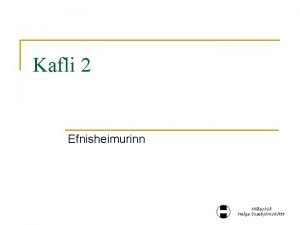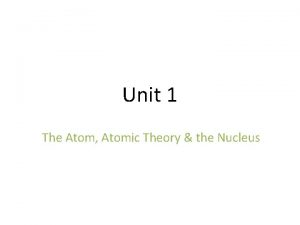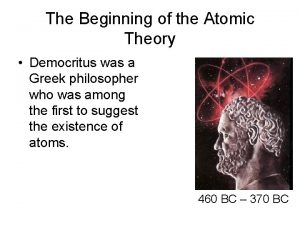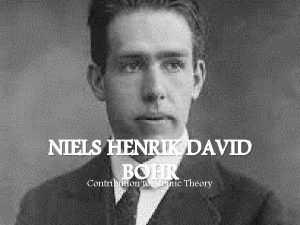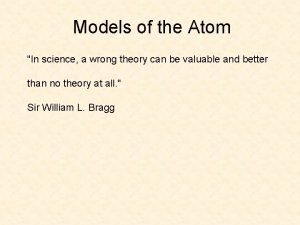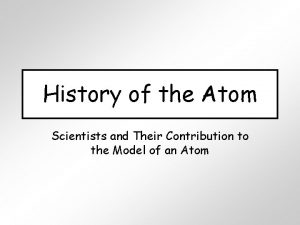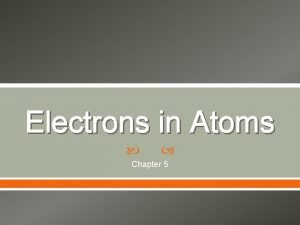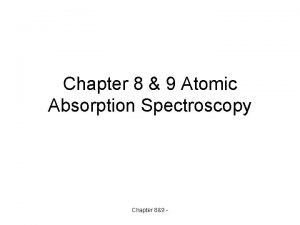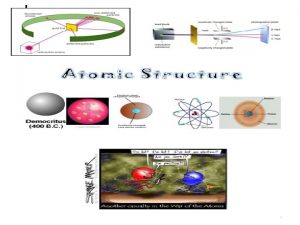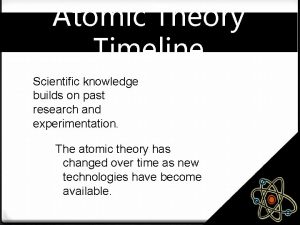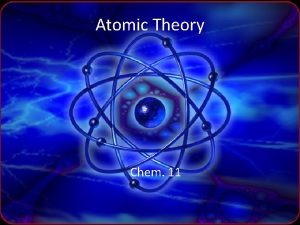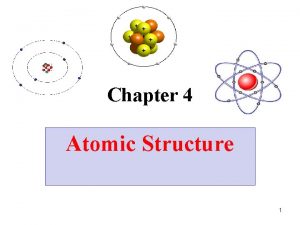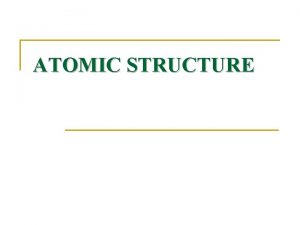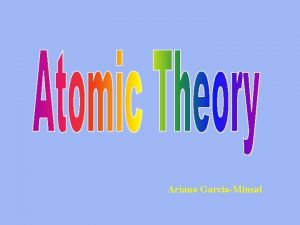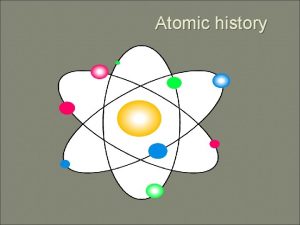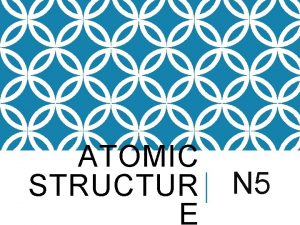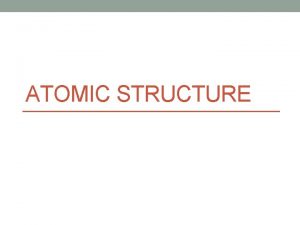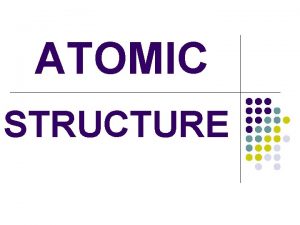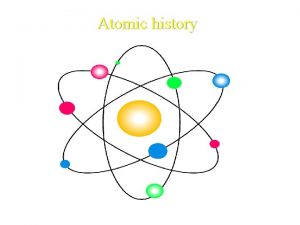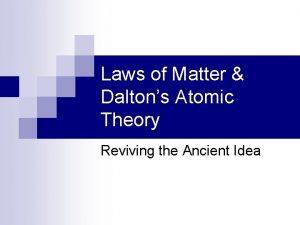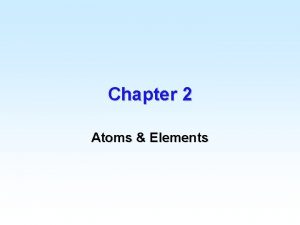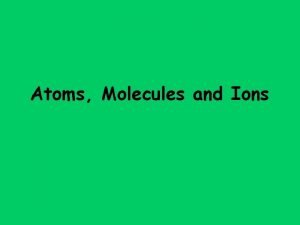Atomic Structure Ch 4 Daltons Atomic Theory 1




















- Slides: 20

Atomic Structure - Ch 4

Daltons Atomic Theory • 1. All elements are composed of tiny indivisible particles called atoms. • 2. Atoms of the same element are identical. The atoms of one element are different from the atoms of another element. • 3. Atoms of different elements can physically mix together or can chemically combine in simplewhole number ratios to form compounds. • 4. Chemical reactions occur when atoms are separated, joined or rearranged.

Modern Atomic Theory v All matter is composed of atoms v Atoms cannot be subdivided, created, or destroyed in ordinary chemical reactions. However, these changes CAN occur in nuclear reactions! v. Atoms of an element have a characteristic average mass which is unique to that element. v. Atoms of any one element differ in properties from atoms of another element

The Discovery of an Electron • 1897 - J. J. Thompson used a cathode ray tube to deduce the presence of a negatively charged particle

So… what? q Cathode rays have identical properties regardless of the element used to produce them. All elements must contain identically charged electrons. q. Atoms are neutral, so there must be positive particles in the atom to balance the negative charge of the electrons q Electrons have so little mass that atoms must contain other particles that account for most of the mass

Thompson’s Atomic Model • Thomson believed that the electrons were like plums embedded in a positively charged “pudding, ” thus it was called the “plum pudding” model.

Rutherford’s Gold Foil Experiment q Alpha ( ) particles are helium nuclei q Particles were fired at a thin sheet of gold foil q Particle hits on the detecting screen (film) are recorded

What did he find? q. Most of the particles passed right through q. A few particles were deflected q. VERY FEW were greatly deflected q. The nucleus is small q. The nucleus is dense q. The nucleus is positively charged

Subatomic Particles



Atomic Number Atomic number (Z) of an element is the number of protons in the nucleus of each atom of that element. Element # of protons Atomic # (Z) 6 6 Phosphorus 15 15 Gold 79 79 Carbon

Mass Number Mass number is the number of protons and neutrons in the nucleus of an isotope. Mass # = p+ + n 0 Nuclide p+ n 0 e- Mass # Oxygen - 16 8 33 8 42 8 16 15 16 33 15 75 31 Arsenic - 75 Phosphorus - 31

IONS! • Atoms or groups of atoms with a positive or negative charge. • Taking away an electron from an atom gives a CATION with a positive charge • Adding an electron to an atom gives an ANION with a negative charge. To tell the difference between an atom and an ion, look to see if there is a charge in the superscript! Examples: Na+ Ca+2 I- O-2 Na Ca I O

Isotopes are atoms of the same element having different masses due to varying numbers of neutrons. Isotope Protons Electrons Neutrons Hydrogen– 1 (protium) 1 1 0 Hydrogen-2 (deuterium) 1 1 1 Hydrogen-3 (tritium) 1 1 2 Nucleus

Isotopes of Sodium

Average Atomic Masses Atomic mass is the average of all the naturally occurring isotopes of that element. Isotope Symbol Composition of the nucleus % in nature Carbon-12 12 C 6 protons 6 neutrons 98. 89% Carbon-13 13 C 6 protons 7 neutrons 1. 11% Carbon-14 14 C 6 protons 8 neutrons <0. 01% Carbon = 12. 011

Average Atomic Mass • (% of isotope 1)(mass of one atom of isotope 1)+(% of isotope 2)(mass of isotope 2)+……….

Calculate atomic mass • Because of the existence of isotopes, the mass of a collection of atoms has an average value. • 6 Li = 7. 5% abundant and 7 Li = 92. 5% • Avg. Atomic mass of Li = _______ • 28 Si = 92. 23%, 29 Si = 4. 67%, 30 Si = 3. 10% • Avg. Atomic mass of Si = _______

Summary • Number of Protons = Atomic Number • Number of Electrons = Number of Protons = Atomic Number (unless it’s an ion!) • Number of Neutrons = Mass Number Atomic Number • Round average atomic mass to get the mass number
 Daltons gas law
Daltons gas law Gaylussacs law
Gaylussacs law Sameindamassi
Sameindamassi John dalton's atomic model
John dalton's atomic model Daltons experiment
Daltons experiment Relative formula mass of hcl
Relative formula mass of hcl Periodic trend
Periodic trend Ionic radius trends
Ionic radius trends Is atomic mass and relative atomic mass the same
Is atomic mass and relative atomic mass the same Difference between atomic mass and atomic number
Difference between atomic mass and atomic number Atomic number vs atomic radius
Atomic number vs atomic radius 460+370
460+370Sir james chadwick atomic theory
 Democritus atomic model
Democritus atomic model Contribution of neil bohr in chemistry
Contribution of neil bohr in chemistry Erwin schrödinger model of atom
Erwin schrödinger model of atom Erwin schrödinger contribution to atomic theory
Erwin schrödinger contribution to atomic theory Atomic theory timeline
Atomic theory timeline Theory of atomic absorption spectroscopy
Theory of atomic absorption spectroscopy 400 bc democritus
400 bc democritus Scientific theory timeline
Scientific theory timeline
